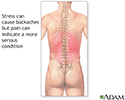Cognitive behavioral therapy for back pain
Nonspecific back pain - cognitive behavioral; Backache - chronic - cognitive behavioral; Lumbar pain - chronic - cognitive behavioral; Pain - back - chronic - cognitive behavioral; Chronic back pain - low - cognitive behavioral
Cognitive behavioral therapy (CBT) can help many people deal with chronic back pain.
What is CBT?
CBT is a form of psychological therapy. It most often involves 10 to 20 meetings with a therapist. Focusing on your thoughts makes up the cognitive part of CBT. Focusing on your actions are the behavioral part.
First, your therapist helps you recognize the negative feelings and thoughts that occur when you have back pain. Then your therapist teaches you how to change those into helpful thoughts and healthy actions. Changing your thoughts from negative to positive can help you manage your pain.
How Does CBT Work?
It is believed that changing your thoughts about pain can change how your body responds to pain.
You may not be able to stop physical pain from happening. But, with practice, you can control how your mind manages the pain. An example is changing a negative thought, such as "I cannot do anything anymore," to a more positive thought, such as "I dealt with this before and I can do it again."
A therapist using CBT will help you learn to:
- Identify negative thoughts
- Stop negative thoughts
- Practice using positive thoughts
- Develop healthy thinking
Healthy thinking involves positive thoughts and calming your mind and body by using techniques such as yoga, massage, or imagery. Healthy thinking makes you feel better, and feeling better reduces pain.
CBT can also teach you to become more active. This is important because regular, low-impact exercise, such as walking and swimming, can help reduce back pain over the long run.
For CBT to help reduce pain, your treatment goals need to be realistic and your treatment should be done in steps. For example, your goals may be to see friends more and start exercising. It is realistic to see one or two friends at first and take short walks, maybe just down the block. It is not realistic to reconnect with all of your friends all at once and walk 3 miles (5 kilometers) at once on your first outing. Exercise can help you to deal with chronic pain issues.
Getting Started
Ask your health care provider for the names of a few therapists and see which ones are covered by your insurance.
Contact 2 to 3 of the therapists and interview them on the phone. Ask them about their experience with using CBT to manage chronic back pain. If you do not like the first therapist you speak to or see, try someone else.
References
Henschke N, Ostelo RW, van Tulder MW, Vlaeyen JW, Morley S, Assendelft WJ, Main CJ. Behavioural treatment for chronic low-back pain. Cochrane Database Syst Rev . 2010;(7). PMID: 20614428 www.ncbi.nlm.nih.gov/pubmed/20614428 .
Stone J, Carson A. Functional and dissociative (phychogenic) neurological symptoms. In: Daroff RB, Fenichel GM, Jankovic J, Mazziotta JC, eds. Bradley's Neurology in Clinical Practice . 6th ed. Philadelphia, PA: Elsevier Saunders; 2012:chap 82.
Turk DC. Psychosocial aspects of chronic pain. In: Benzon HT. Practical Management of Pain . 5th ed. Philadelphia, PA: Elsevier Mosby; 2014:chap 12.
-
Backaches - illustration
Although stress can cause backaches it is wise to watch out for other signs that may indicate a more serious condition. Pain which radiates to the buttocks, arms or legs, and weakness or numbness in the arms and legs should not be ignored.
Backaches
illustration
-
Back pain and sciatica
(In-Depth)
-
Fibromyalgia
(In-Depth)
-
Tension headache
(Alt. Medicine)
-
Temporomandibular joint dysfunction
(Alt. Medicine)
-
Exercise
(In-Depth)
-
Anxiety disorders
(In-Depth)
-
Sickle cell disease
(In-Depth)
-
Stress
(In-Depth)
-
Depression
(Alt. Medicine)
-
Headaches - cluster
(In-Depth)
Review Date: 8/14/2015
Reviewed By: Linda J. Vorvick, MD, Medical Director and Director of Didactic Curriculum, MEDEX Northwest Division of Physician Assistant Studies, Department of Family Medicine, UW Medicine, School of Medicine, University of Washington, Seattle, WA. Also reviewed by David Zieve, MD, MHA, Isla Ogilvie, PhD, and the A.D.A.M. Editorial team.

